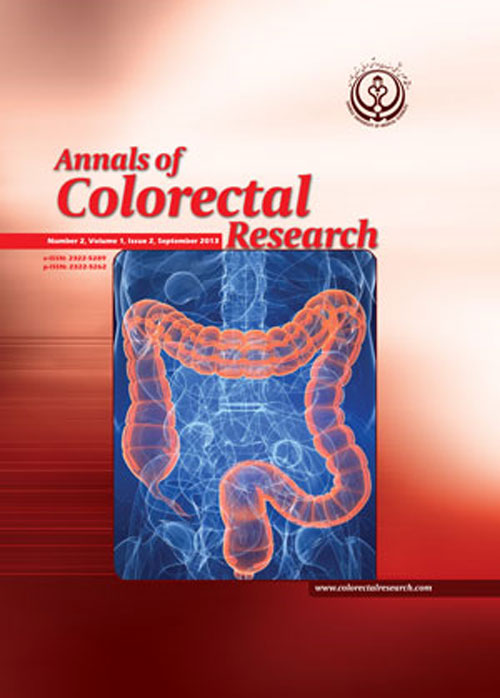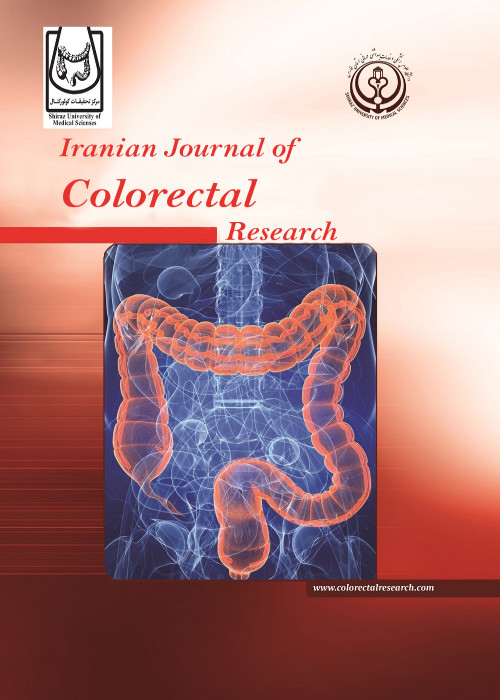فهرست مطالب

Iranian Journal of Colorectal Research
Volume:2 Issue: 2, Jun 2014
- تاریخ انتشار: 1393/07/01
- تعداد عناوین: 9
-
-
Page 1Context: Sacrococcygeal pilonidal disease is a common cause of patient’s referral to colorectal surgery services. Recently, numerous reports published about management of patients with pilonidal disease..Evidence Acquisition: In this review, we gathered all the recent ten years evidences indexed in the PubMed database..ResultsSurgical management has been changed from invasive excision and secondary healing to minimal invasive and non-operative, primary closure methods and flap based techniques. Developing laser epilation had promising effects on reducing recurrence rate. Most of surgical techniques efficacy are shown with well-controlled studies..ConclusionsAlthough recent evidences seems to describe current techniques efficacy but the absence of standardized pilonidal staging system made comparison of studies difficult and newer studies should be done regarding this issue..Keywords: Pilonidal Sinus, Surgery, Review
-
Page 2BackgroundColorectal carcinoma is the third most commonly diagnosed cancer worldwide and many studies have focused on its molecular basis. BRAF V600E is the single most important mutation of this gene in cancers. It shows variable, but usually low, frequency in colorectal cancer, but is associated with distinct histologic, prognostic and molecular features. It is highly associated with MSI (microsatellite instability), CIMP-H (CpG island methylator phenotype), serrated pathway, poor prognosis and resistance to anti-EGFR (epidermal growth factor) drugs and interestingly absent in Lynch syndrome..ObjectivesIn this study, we analyzed BRAF V600E mutation in colorectal cancer in Iranian patients..Patients andMethodsOne hundred patients with colorectal cancer, operated in hospitals affiliated to Shiraz University of medical Sciences (Faghihi and Namazi Hospital) were selected. The cases were chosen from the pathology files of the above mentioned hospitals, during 2011-2013. Genomic DNA were extracted from the paraffin blocks, by the DNP TM kit, amplified using conventional PCR and DNA sequenced using the automated sequencer (Sanger method)..ResultsPatients were 21-87 years old (mean = 59.8), 45% female and 55% male. Thirty percent of the cases had right-sided and 70% left-sided cancer, of which 83% were well and 17% moderately differentiated. No BRAF V600E mutation was detected in these 100 cases..ConclusionsThe BRAF mutation is not common in colorectal cancer patients in the South of Iran. Our results are very similar to very few previous studies conducted in Iran, although we suggest further studies with larger numbers of patients to confirm these results..Keywords: Colorectal Cancer, Gene, Iran
-
Page 3BackgroundEndorectal ultrasonography is a diagnostic modality for evaluation of perianal pathologies and suitable surgical planning, especially in perianal fistula, due to its close relation to the anal sphincter complex. Detection of anatomical location of fistula tract and abscess is critical to select the best procedure..ObjectivesThis study tries to demonstrate the accuracy of endorectal ultrasonography in mixed group of patients in diagnosing perianal fistula during two years, retrospectively..Patients andMethodsAfter Ethics Committee approval, all endorectal ultrasonography reports of all patients with perianal fistula referred to Shiraz Endorectal Ultrasonography Clinic of Shiraz colorectal research center between 2010 and 2012 were gathered. All endorectal ultrasonographies in this center was perform by a colorectal surgeon with BK Medical Class I type B Ultrasonography scanner with 12 MHz probe..ResultsFinally, 183 cases of perianal fistula were enrolled in the study. Operation notes were evaluated and the type of fistula was compared with ultrasound findings. This study showed that endorectal ultrasonography has adequate accuracy with 97.92% sensitivity and acceptable 89.53% specificity in diagnosis of perianal fistula. Compared with other reports, it seems that endorectal ultrasonography is an acceptable diagnostic tool for detecting perianal fistula compared with other diagnostic modalities..ConclusionsEndoanal sonography would be one of the high sensitive modalities for evaluation of perianal fistula. Detection of anatomy of fistula helps surgeon to choose best method for surgery.Keywords: Ultrasonography, Fistula, Sensitivity, Specificity
-
Page 4BackgroundThe use of statistical methods to analyze data, regardless of their theoretical assumptions, leads to misinterpretation of the results..ObjectivesEffective attributes in colorectal cancer relapse were investigated through survival analysis in the present study. Comparison between the results of artificial neural network (ANN) method and Cox proportional hazards (Cox PH) model was the main purpose of this research..Patients andMethodsA total of 184 patients with locoregional colorectal cancer, referred to Shahid Faghihi Hospital (Shiraz, Iran) for surgery, were followed in a five-year period for possible relapse during 2003-2011. Disease-free survival was then modeled based on the patients’ attributes, using Cox PH regression and ANN methods. All the attributes effective on disease relapse were investigated by these two methods..ResultsA total of 114 (62%) males and 70 (38%) females with a median age of 54 (range: 23-84) years old participated in the study. Among them, there were 95 (51.6%) patients with colon cancer and 89 (48.4%) with rectum cancer. In addition, 53 patients relapsed and 131 patients did not present any relapse or missed the follow up (censored data). The results showed that the accuracy rate in prediction was higher for the ANN method than the Cox PH model (78.2% versus 72.7%). In addition, the area under the receiver operating curve (ROC) was also more for the ANN method (0.86 versus 0.74). Five attributes of the patients, including neoadjuvant treatment, perforation and/or obstruction, perineural invasion, stage, and tumor grade, were significant through the Cox HP model. The first five attributes by the ANN method were surgeon, primary tumor site, perforation and/or obstruction, age, and adjuvant treatments. In this study, the order of attributes determined by the ANN method was rather confirmed by the physicians..ConclusionsThe results showed superiority of the ANN method over the Cox PH model with respect to the area under the ROC and the accuracy rate in prediction. However, this method requires a large data set to learn the relations and cannot distinguish the confounding attributes.Keywords: Colorectal Cancer, Artificial Neural Network Method, Cox Proportional Hazards Model, Relapse
-
Page 5IntroductionForeign materials typically produce a reaction by multinucleated giant cells. Foreign bodies (such as vegetable cells in food material) in the omentum have not been reported to produce an omental mass. Vegetable cells surrounded by foreign body giant cells called vegetable granuloma/pulse granuloma by the previous literature are a peculiar type of granuloma caused by vegetable plant cells..Case PresentationHere in we present our experience with an old age lady who was operated with the impression of gastric mass. During the surgery no gastric mass was found but several omental masses were detected. Pathological study of the resected masses showed only vegetable cells in the omentum surrounded by an extensive foreign body giant cell granulomatous reaction, some of which were hyalinized. To the best of our knowledge such situation has not been reported in the English literature thus far..ConclusionsIn a patient with several omental granuloma, both in surgery and pathological examination, foreign body granuloma should be considered as a possible differential diagnosis.Keywords: Vegetable Granuloma, Omental Mass, Colon


